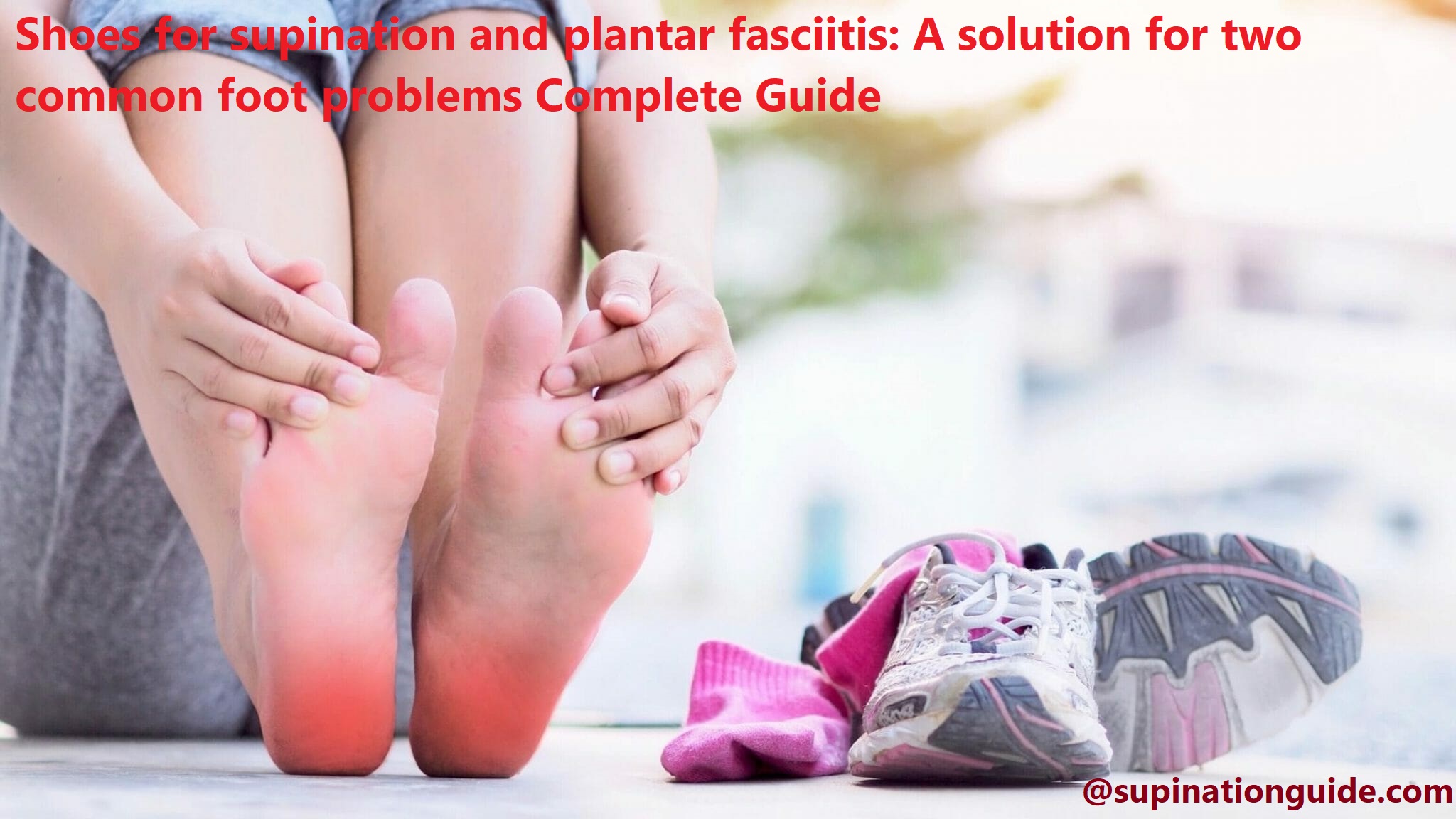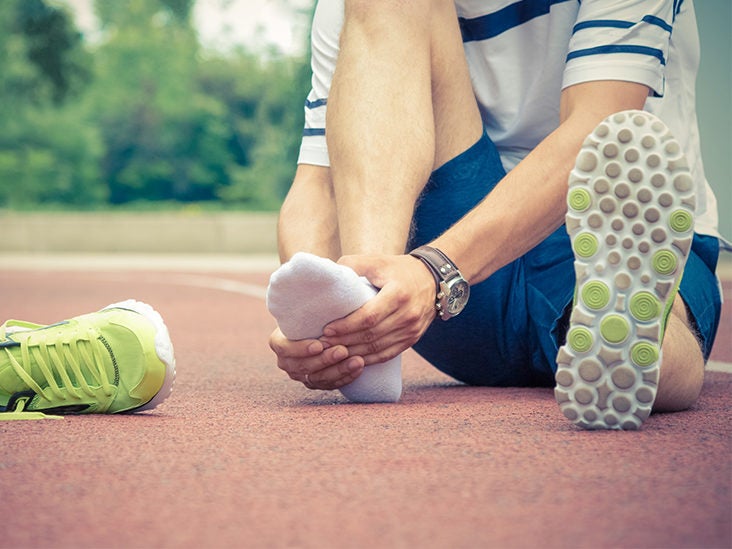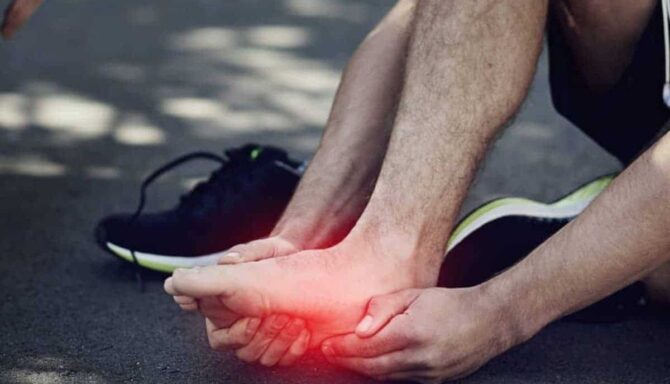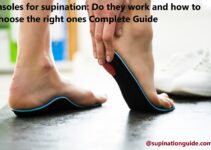If you suffer from supination or plantar fasciitis, finding the right shoes can be a daunting task. But don’t stress anymore!
In this guide, you’ll learn how to choose shoes for these common foot problems and ensure your feet stay healthy.
Having a good quality pair of shoes is essential for those dealing with foot problems such as supination and plantar fasciitis. However, finding the right pair of shoes can be a challenge.
In this guide, we will discuss what features to look for in a shoe specifically designed to aid with these two common foot problems and how to find the perfect fit for your feet. Additionally, we will provide some tips on taking care of your feet so that you can reduce the pain associated with these issues.
With the right shoes and proper foot care, you can rest assured that you’ll be able to stay on your feet longer and keep yourself comfortable while doing the activities you love.
Understanding Supination
Supination, or under-pronation, is a common foot issue in which the foot lacks stability due to decreased mobility when pushing off the ground. It’s what happens when someone’s arch collapses during walking or running, leading to an excessive rotation of the foot and ankle toward the outside of their body.
When someone supinates they are putting greater pressure on the outside edge of their feet since they are relying solely on this area for support instead of spreading it out with proper pronation. This can cause increased strain on muscles and tendons, resulting in tissue fatigue and pain. Supinating can also lead to ankle instability as well as trapping nerves under certain areas of skin and tissue causing numbness and tingling sensations. Plus, people who suffer from plantar fasciitis often have a tendency towards supination.
To help manage your supination challenges, consider investing in a pair of motion control shoes with superior cushioning designed specifically for this type of pronation imbalance. Motion control shoes provide targeted support that cradles your arches for maximal stability just where you need it most — on outdoor surfaces such as paved sidewalks or uneven paths — while keeping your feet well protected from physical shockwaves encountered through running or walking activities. And because these shoes also help alleviate symptoms associated with plantar fasciitis (PF), wearing them can reduce both pain and stress caused by PF or supination issues simultaneously.

Definition of supination
Supination, also known as underpronation, is the term used to describe an action in which most of the weight (and stress) bearing involved takes place on the outside edge of your foot. During supination, the foot rolls outward at the ankle when walking or running and weight is transferred away from where it should occur – across the midsole of your foot and to your toes.
This can cause significant discomfort, as well as several common injuries associated with insufficient cushioning and support such as plantar fasciitis. To combat this problem and reduce injury risk, you need to ensure that your footwear is suitable for both supination and plantar fasciitis (such as shoes with appropriate cushioning).
Causes and symptoms
Supination and plantar fascia are two of the most common types of foot issues that can cause pain and an inability to walk or stand comfortably. It is important to understand the causes and symptoms of these conditions in order to ensure that you choose the correct shoe for your particular condition.
The causes of supination vary from person to person, but it usually involves weakened ber muscles and ligaments, as well as improper foot alignment. Common causes include: ill-fitting shoes with too narrow of a heel base; wearing high heels; prolonged periods of standing without adequate cushioning for the feet; flat feet; overpronation (excessive inward rolling of the foot); structural defects such as high arches; and injury, such as a fracture or sprained ankle resulting from excessive force or twisting the ankle or foot.
Supination can cause symptoms such as pain on the outside of your ankle joint when walking, running or jogging which may radiate down into your feet, especially if you have flat feet; reduced range-of-motion in your ankles due to stiffness in joint ligaments and muscles on the outside edge; shin splint symptoms along with burning pain on the outside edges of your shins when running or jogging due to rolling outwards too much with each step; poor shock absorption resulting in extra stress on joints while walking or running leading to tiredness in legs sooner than usual.
Plantar fasciitis is an inflammatory condition caused by excessive stretching and tearing of plantar fascia – a band of fibrous connective tissue from heel bone to toes which supports arch structure during locomotion. Common causes include inadequate arch support when walking due to ill-fitting shoes with insufficient cushioning for shock absorption, repetitive strain fractures caused by continuous dipping activity like long-distance walking, working standing up for long periods at a time without breaks, obesity resulting from excess pressure loading through soles on very hard surfaces when standing up for long hours at home, inflexible calves due to lack exercises resulting in increased strain around lower back area during locomotion along with pressure loading at sole that adds more work load onto already strained plantar fascia bands – thus causing inflammation and pain over arch structures as well as outer edges surrounding heel area which can become worse while walking or running.
The importance of wearing shoes for supination
Having the appropriate footwear for supination is important, as it can help reduce strain on sensitive areas such as the plantar fascia. Shoes that are designed to provide proper arch support can act as a buffer between your foot and the ground, providing extra cushioning and stability. Properly supporting your feet can also help your body maintain an even stride, helping to reduce strain on other muscles. Your shoes should have plenty of padding, including in the area of your ankle and heel. Additionally, shoes with motion control properties that focus on guiding your foot into its correct position with each step may be helpful.
It is also important to consider arch height when searching for shoes to support supination. Finding a balance between high enough arch support to relieve pressure while still allowing some “give” is key—if the arch support is too high, it can cause undue pressure around vulnerable areas of the foot. Finally, selecting shoes with adequate ground clearance—from the sole of the shoe up to the sides above—can help protect against abrasions and cuts from rocks or other objects encountered during activities like hiking or running outdoors.
By choosing shoes specifically designed for individuals who pronate more than normal, you may experience improved overall comfort and suffer from fewer aches and pains in both feet and throughout your body.
Understanding Plantar Fasciitis
Plantar fasciitis is a common condition where inflammation of the plantar fascia, a thick band of tissue that stretches from the heel to the base of your toes, causes pain at the bottom of your foot. This condition typically occurs as a result of overuse, repetitive activities such as running on hard surfaces or ill-fitting shoes. The tissue gets stretched beyond its normal range and becomes inflamed, leading to sharp pain when you put pressure on your feet.
If you are experiencing pain in the heel or bottom of your foot associated with plantar fasciitis, it is important to take measures to reduce discomfort and prevent further injury. Shoes specifically designed for supination and plantar fasciitis can provide relief for people suffering from these issues by providing added arch support and cushioning for painful areas. However, it’s important to understand some basic facts about this condition in order to select an optimal solution for your needs.
This section provides information on plantar fasciitis symptoms and diagnosis, causes and risk factors for developing the condition ,treatment options that can help reduce pain and discomfort, tips for preventing future issues ,and more.
Definition of Plantar Fasciitis
Plantar fasciitis is a disorder commonly affecting the feet, especially the heels and arches, that causes intense pain and discomfort. It occurs when the thick band of tissue that supports your arch—the plantar fascia—becomes torn or strained due to injury or overuse.
The condition can be especially difficult to handle since it is quite uncomfortable and can lead to further issues if left untreated.
Plantar fasciitis is often caused by increased physical activity, wear and tear on tight-fitting shoes or standing for long periods of time on hard surfaces. People who are overweight are particularly at risk for plantar fasciitis due to the extra pressure placed on their feet when running or walking. It can also be caused by certain medical conditions such as arthritis or flat feet (pes planus).
If you have been experiencing chronic heel pain, it is important to seek medical help as soon as possible so as to avoid further complications resulting from this condition. Treatment options include stretching exercises, massage therapy, shoe orthotics that act as cushioning support and non-steroidal anti-inflammatory drugs (NSAIDs). Corrective shoes with arch support may also help reduce pain associated with plantar fasciitis in some cases.
Causes and symptoms
Supination and plantar fasciitis are common foot conditions that can cause pain and discomfort when walking or running. Both of these conditions can lead to long-term complications if they are not managed properly. It is important to understand the causes and symptoms of each condition in order to take proactive steps towards prevention, or to select the right shoes for effective treatment.
Supination occurs when your foot rolls outward when you walk or run, causing too much weight and stress on the outside of your feet. This condition often occurs in people with high arches. Common symptoms include frequent ankle sprains, heel pain, knee pain, arch pain, and shin splints.
Plantar fasciitis is an inflammation of the tissue on the bottom of your foot (known as the plantar fascia) that connects the heel bone to your toes. Most cases are caused by overuse or excessive stretching of the tissue due to activities such as running or prolonged standing. Common symptoms include severe heel pain at the bottom of your feet when you first get out bed in the morning that decreases throughout the day but returns after extended periods of standing or walking.
The importance of wearing shoes for Plantar Fasciitis
Plantar fasciitis is an inflammation of the thick tissue that runs along the bottom of your foot, connecting your heel bone to your toes. It’s a common cause of heel pain and can make activities such as walking and running incredibly painful. Wearing good shoes for Plantar Fasciitis is one of the most important treatments when it comes to alleviating the symptoms. Prolonged periods spent on hard, unforgiving surfaces can aggravate the condition, making it difficult to use your feet without experiencing significant discomfort.
Finding shoes for Plantar Fasciitis can be a difficult task for those who are unfamiliar with what features and construction should be sought after when selecting footwear for this condition. When choosing a shoe for Plantar Fasciitis, look for sole support, cushioning and stability around the midfoot area, as well as plenty of arch support. Other features are related to additional cushioning: air cushioning designed specifically to absorb shock, or foam cushioning designed to provide all day comfort while still delivering stability.
Supination is another condition that requires specific footwear considerations when selecting shoes in order to prevent further health issues associated with this condition. Supination occurs when you don’t roll your feet inward enough when walking or running; if not treated properly or supported with proper footwear this can lead to ankle instability and even rolled ankles in extreme cases due to inadequate shock absorption and reduced pronation control during higher impact aerobic activities like running or jumping. Good supinator shoes should have adequate sole support coupled with plenty of cushioning which both helps keep pronation in check and provide needed comfort during prolonged usage sessions like running marathons. Moreover, stability should also be taken into account due to its role in providing lateral motion control which helps prevent rolled ankles from occurring in extreme cases where excessive supination exists on certain parts of your feet such as high arches present on some individuals.

Characteristics of Shoes for Supination and Plantar Fasciitis
When selecting shoes for supination or plantar fasciitis, it’s important to keep in mind that the design of the shoe should provide both cushioning and support. The more supportive the shoe, the better it will be at providing relief from your condition.
Cushioning: The first step is soft cushioning. Look for shoes with a foam-cushioned midsole that helps absorb shock and protect your feet against potential injury. If you are suffering from plantar fasciitis, look for a individual heel or a shock-absorbing gel insert that provides additional cushioning.
Support: Shoes made to treat supination or plantar fasciitis should provide arch support and an adequate level of stability and control over pronation (inward rolling) as you walk. A semi-rigid midsole may help your feet to stay stable while still allowing flexibility at toe off in order to reduce strain on foot tendons caused by rigid motion. Furthermore, many brands incorporate technology such as AbzorbTM designed specifically to aid those with foot problems. Finally, look for shoes with durable, slip-resistant outsoles that provide grip on wet surfaces preventing slipping or falling onto hard surfaces which can cause serious injury.
Stability: Shoes suited to treat your condition should also include features like rocker soles which help promote forward motion in each step while limiting joint stiffness caused by excessive foot pronation (inward rolling). Furthermore be sure to check whether lace closures are adjustable enough so you get a snug fit ensuring sufficient ankle stability for walking confidently on uneven terrain and during activities like jogging or dancing, when extra support is necessary.
Arch Support
Having proper arch support is the key to reducing pain associated with supination and plantar fasciitis. Proper arch support means cushioning and bracing the inner curve of the foot. Many people with supination will opt for a shoe with an inflexible sole that supports both medial and lateral arch placement, while those with plantar fasciitis will benefit from a cushioned sole made from flexible material that can absorb shock and redistribute pressure across the entire foot.
Good shoes for addressing these two foot problems should also offer adequate cushioning along their length and width, as well as protection against pronation at heel strike. Thick, lightweight soles are beneficial in this regard. Choose shoes with durable construction made from breathable fabrics that allow ventilation. Shoes featuring memory foam or gel padding throughout their interior will go a long way in cushioning feet against shock and painful impact when walking or running. Look for shoes with deep heels cups, sufficient toe box space, firm yet flexible outsoles and good arch support that provide stability without restricting range of motion in size.
Cushioning
For those with supination or plantar fasciitis – or both – finding the right cushioning is crucial. Cushioning helps relieve pressure on the bottom of the foot by softening shock absorption. Correctly fitting shoes that support your feet all day can help to alleviate pressure and provide you with comfortable, good-fitting footwear. Shoes with cushioning should also be lightweight and flexible to promote natural motion of your feet, reducing strain and increasing comfort levels.
When selecting shoes for supination and plantar fasciitis, it is essential to look for padding that is cushioned along the length of the sole of the shoe from heel to toe – especially any areas found around bunions or protrusions where there may be significant discomfort. The outsole should also be good quality for extra support and shock absorption. Look for cushioning in materials such as EVA foam, polyurethane foam, rubber, leather or fabric as they are usually lightweight while providing a good level of cushioning and shock protection. As well as this, consider using insoles designed specifically for arch support or techniques such as orthotic shoe inserts which will help ease pain in arch areas too.
Firm Heel Counter
A firm heel counter is an important feature to look out for if you have supination or plantar fasciitis. A shoe’s heel counter provides extra stability and support by wrapping closely around the sides of your foot.
Shoes with firm heel counters can help provide stabilizing support and protection when walking, running, or hiking on uneven surfaces. Firm heel counters also protect against accidental twisting of your foot especially if you’re doing sports that require agility such as basketball, volleyball, and soccer.
Look for shoes with a solid structure and preferably leather heels that wrap securely around your feet. The firmer the heel counter, the more stable and supported your feet will be when you move. If you have plantar fasciitis, this is particularly important because it will help reduce the amount of pain caused by your condition.
Conclusion
In conclusion, it is important to find a shoe that offers both supportive cushioning and stability to help protect your feet from the potential pain associated with supination or plantar fasciitis. Take time to consult a doctor or a knowledgeable shoe-fitter to help identify the type of shoe that best fits your individual needs.
Also, focus on quality construction and understand that shoes should not be an expense you try to cut corners on when it comes to your health. Spend some time in researching the right shoe for you, as this will determine how quickly you will be able to reduce symptoms and become comfortable with physical activity again.

FAQ’s
What type of shoes help plantar fasciitis?
Shoes that provide good arch support, cushioning, and stability help with plantar fasciitis.
What shoe is best for supination?
A shoe with good cushioning and shock absorption is ideal for supination.
What are 2 methods to help treat plantar fasciitis?
Stretching exercises and wearing supportive shoes are two effective ways to treat plantar fasciitis.
Is it better to wear shoes with plantar fasciitis?
Yes, it is better to wear supportive shoes when suffering from plantar fasciitis.
What are 2 symptoms of plantar fasciitis?
Heel pain and stiffness in the foot are two common symptoms of plantar fasciitis.
What shoes do orthopedic doctors recommend?
Orthopedic doctors typically recommend shoes that offer good arch support, cushioning, and stability.
Are Skechers good for your feet?
Skechers offers a range of shoes, some of which provide good arch support and cushioning, making them beneficial for your feet.
What type of shoes are best for your feet?
Shoes that provide good arch support, cushioning, and stability are generally the best for your feet.
What are the best shoes to wear when you have foot problems?
Orthopedic shoes that provide good support and cushioning are the best shoes to wear when you have foot problems.
What are 7 common foot problems?
Bunions, corns, calluses, plantar fasciitis, ingrown toenails, flat feet, and heel spurs are some of the common foot problems.
See Also :
- Best insoles for supination
- Best new balance for supination
- Best nike for supination
- Best orthotics for supination
- Best running shoes for supination mens


